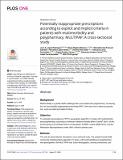Files in this item
Potentially inappropriate prescriptions according to explicit and implicit criteria in patients with multimorbidity and polypharmacy. MULTIPAP : a cross-sectional study
Item metadata
| dc.contributor.author | Lopez-Rodriguez, Juan A. | |
| dc.contributor.author | Rogero-Blanco, Eloísa | |
| dc.contributor.author | Aza-Pascual-Salcedo, Mercedes | |
| dc.contributor.author | Lopez-Verde, Fernando | |
| dc.contributor.author | Pico-Soler, Victoria | |
| dc.contributor.author | Leiva-Fernandez, Francisca | |
| dc.contributor.author | Prados-Torres, J. Daniel | |
| dc.contributor.author | Prados-Torres, Alexandra | |
| dc.contributor.author | Cura-González, Isabel | |
| dc.contributor.author | MULTIPAP group | |
| dc.contributor.author | Azcoaga-Lorenzo, Amaya | |
| dc.date.accessioned | 2020-09-16T09:30:04Z | |
| dc.date.available | 2020-09-16T09:30:04Z | |
| dc.date.issued | 2020-08-12 | |
| dc.identifier | 269967756 | |
| dc.identifier | 5f17d0f4-479e-420a-ab2a-02ac078922c1 | |
| dc.identifier | 85089408219 | |
| dc.identifier.citation | Lopez-Rodriguez , J A , Rogero-Blanco , E , Aza-Pascual-Salcedo , M , Lopez-Verde , F , Pico-Soler , V , Leiva-Fernandez , F , Prados-Torres , J D , Prados-Torres , A , Cura-González , I , MULTIPAP group & Azcoaga-Lorenzo , A 2020 , ' Potentially inappropriate prescriptions according to explicit and implicit criteria in patients with multimorbidity and polypharmacy. MULTIPAP : a cross-sectional study ' , PLoS One , vol. 15 , no. 8 , e0237186 . https://doi.org/10.1371/journal.pone.0237186 | en |
| dc.identifier.issn | 1932-6203 | |
| dc.identifier.other | ORCID: /0000-0003-3307-878X/work/79918447 | |
| dc.identifier.uri | https://hdl.handle.net/10023/20629 | |
| dc.description.abstract | Background Multimorbidity is a global health challenge that is associated with polypharmacy, increasing the risk of potentially inappropriate prescribing (PIP). There are tools to improve prescription, such as implicit and explicit criteria. Objective To estimate the prevalence of PIP in a population aged 65 to 74 years with multimorbidity and polypharmacy, according to American Geriatrics Society Beers Criteria® (2015, 2019), the Screening Tool of Older Person’s Prescription -STOPP- criteria (2008, 2014), and the Medication Appropriateness Index -MAI- criteria in primary care. Methods This was an observational, descriptive, cross-sectional study. The sample included 593 community-dwelling elderly aged 65 to 74 years, with multimorbidity and polypharmacy, who participated in the MULTIPAP trial. Socio-demographic, clinical, professional, and pharmacological-treatment variables were recorded. Potentially inappropriate prescribing was detected by computerized prescription assistance system, and family doctors evaluated the MAI. The MAI-associated factors were analysed using a logistic regression model. Results A total of 4,386 prescriptions were evaluated. The mean number of drugs was 7.4 (2.4 SD). A total of 94.1% of the patients in the study had at least one criterion for drug inappropriateness according to the MAI. Potentially inappropriate prescribing was detected in 57.7%, 43.6%, 68.8% and 71% of 50 patients according to the explicit criteria STOPP 2014, STOPP 2008, Beers 2019 and Beers 2015 respectively. For every new drug taken by a patient, the MAI score increased by 2.41 (95% CI 1.46; 3.35) points. Diabetes, ischaemic heart disease and asthma were independently associated with lower summated MAI scores. Conclusions The prevalence of potentially inappropriate prescribing detected in the sample was high and in agreement with previous literature for populations with multimorbidity and polypharmacy. The MAI criteria detected greater inappropriateness than did the explicit criteria, but their application was more complex and difficult to automate. | |
| dc.format.extent | 20 | |
| dc.format.extent | 914877 | |
| dc.language.iso | eng | |
| dc.relation.ispartof | PLoS One | en |
| dc.subject | RM Therapeutics. Pharmacology | en |
| dc.subject | DAS | en |
| dc.subject | SDG 3 - Good Health and Well-being | en |
| dc.subject.lcc | RM | en |
| dc.title | Potentially inappropriate prescriptions according to explicit and implicit criteria in patients with multimorbidity and polypharmacy. MULTIPAP : a cross-sectional study | en |
| dc.type | Journal article | en |
| dc.contributor.institution | University of St Andrews. School of Medicine | en |
| dc.contributor.institution | University of St Andrews. Population and Behavioural Science Division | en |
| dc.identifier.doi | https://doi.org/10.1371/journal.pone.0237186 | |
| dc.description.status | Peer reviewed | en |
This item appears in the following Collection(s)
Items in the St Andrews Research Repository are protected by copyright, with all rights reserved, unless otherwise indicated.

